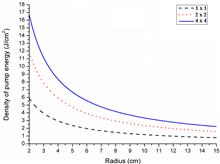
Editor(s):
Year: 2014
Status: Published
A short overview of the theory of acceleration of thin foils driven by the radiation pressure of superintense lasers is presented. A simple criterion for radiation pressure dominance at intensities around 5×1020 W cm-2 is given, and the possibility for fast energy gain in the relativistic regime is discussed.
We develop a splicing technology of Ti:sapphire crystals for a high-energy chirped pulse amplifier laser system that can suppress the parasitic lasing to improve the amplification efficiency compared to a large-size single Ti:sapphire crystal amplifier. Theoretical investigations on the characteristics of the amplifier with four splicing Ti:sapphire crystals, such as parasitic-lasing suppression and amplification efficiencies, are carried out. Some possible issues resulting from this splicing technology, including spectral modulation, stretching or splitting of the temporal profile, and the sidelobe generation in the spatial domain (near field and far field), are also investigated. Moreover, the feasibility of the splicing technology is preliminarily demonstrated in an experiment with a small splicing Ti:sapphire crystals amplifier. The temporal profile and spatial distribution of the output pulse from the splicing Ti:sapphire crystal amplifier are discussed in relation to the output pulse from a single Ti:sapphire crystal amplifier.
The first experimental measurements of intense (-7×1019 W cm-2) laser-driven terahertz (THz) radiation from a solid target which is preheated by an intense pulse of laser-accelerated protons is reported. The total energy of the THz radiation is found to decrease by approximately a factor of 2 compared to a cold target reference. This is attributed to an increase in the scale length of the preformed plasma, driven by proton heating, at the front surface of the target, where the THz radiation is generated. The results show the importance of controlling the preplasma scale length for THz production.
It is demonstrated by simulations and analysis that a wakefield driven by an ultrashort intense laser pulse in underdense plasma can emit tunable electromagnetic radiation along the laser propagation direction. The profile of such a kind of radiation is closely associated with the structure of the laser wakefield. In general, electromagnetic radiation in the terahertz range with its frequency a few times the electron plasma frequency can be generated in the moderate intensity regime. In the highly nonlinear case, a chain of radiation pulses is formed corresponding to the nonlinear structure of the wake. Study shows that the radiation is associated with the self-modulation process of the laser pulse in the wakefield and resulting transverse electron momenta from modulated asymmetric laser fields.
Recently there has been great progress in laser-driven plasma-based accelerators by exploiting high-power lasers, where electron beams can be accelerated to multi-GeV energy in a centimeter-scale plasma due to the laser wakefield acceleration mechanism. While, to date, worldwide research on laser plasma accelerators has been focused on the creation of compact particle and radiation sources for basic sciences, medical and industrial applications, there is great interest in applications for high-energy physics and astrophysics, exploring unprecedented high-energy frontier phenomena. In this context, we present an overview of experimental achievements in laser plasma acceleration from the perspective of the production of GeV-level electron beams, and deduce the scaling formulas capable of predicting experimental results self-consistently, taking into account the propagation of a relativistic laser pulse through plasma and the accelerating field reduction due to beam loading. Finally, we present design examples for 10-GeV-level laser plasma acceleration, which is expected in near-term experiments by means of petawatt-class lasers.














